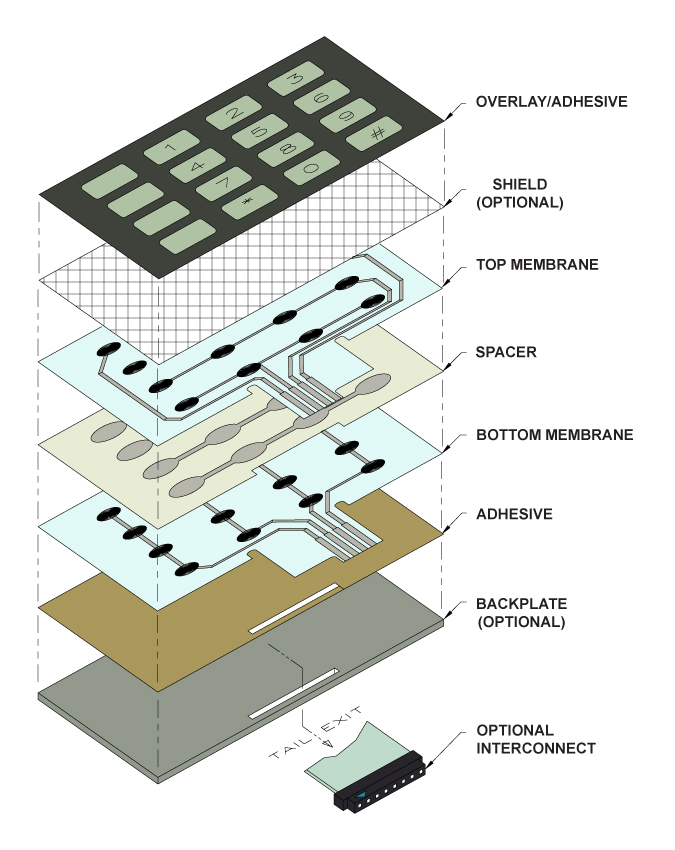How Membrane Layer Changes Add To the Longevity of Electronic Control Panels
Membrane switches play an essential duty in enhancing the resilience of digital control panels, mainly through their multi-layered building which supplies effective defense against environmental elements such as dampness and dust. The absence of moving parts considerably lowers the possibility of mechanical failings, making membrane layer switches suitable for demanding applications.
Definition of Membrane Switches

Membrane buttons are made to be thin and lightweight, making them suitable for applications where room is restricted. They can be manufactured in different shapes, sizes, and colors, providing adaptability in style that satisfies aesthetic and useful demands. Furthermore, membrane layer buttons can integrate different modern technologies, such as responsive comments and LED indicators, boosting customer experience.
Due to their construction, membrane layer switches are commonly resistant to dirt, moisture, and general wear, adding to their resilience sought after settings. Their smooth style not just promotes simple cleaning but likewise minimizes the danger of mechanical failing, making them a preferred selection for producers looking for reputable interface in their electronic control panels.
Security Against Environmental Aspects
The design of membrane layer switches naturally gives a level of defense versus various ecological elements, which is important for keeping performance in tough conditions - Membrane Switch. These buttons are usually created with layers of flexible materials that protect interior elements from dampness, dirt, and pollutants. By encapsulating the wiring, membrane layer switches decrease the threat of short circuits and rust, which can substantially hinder efficiency
In addition, the usage of robust adhesives and sealants during production boosts their resistance to environmental obstacles. Membrane layer buttons can sustain direct exposure to chemicals and solvents, making them suitable for sectors such as food processing and healthcare, where hygiene and tidiness are extremely important. Their smooth surface style also stops the accumulation of dirt and germs, assisting in simpler cleansing and upkeep.
Temperature changes are an additional environmental concern, and membrane switches are engineered to work efficiently across a vast array of temperature levels (Membrane Switch). This adaptability makes certain that control board stay functional in numerous setups, from commercial atmospheres to consumer electronic devices
Effect On Individual Communication
Individual communication with digital control panels is considerably influenced by the style and functionality of membrane layer buttons. These switches supply a tactile user interface that improves the total user experience, enabling intuitive navigating and control. Their responsive nature makes sure that users obtain prompt comments upon activation, which is essential for tasks needing accuracy and effectiveness.
Moreover, the smooth surface of membrane switches over promotes very easy cleaning and upkeep, advertising customer self-confidence in the reliability of the interface. This cleanliness is specifically essential in environments where hygiene is extremely important, such as clinical or food handling settings. In addition, the compact and light-weight design of membrane layer switches over contributes to the visual allure of control board, motivating individual involvement via a modern and smooth look.
Furthermore, the integration of visual elements, such as published symbols and backlighting, helps users quickly identify features, reducing the learning contour connected with brand-new tools. Consequently, individuals can run tools better, leading to enhanced efficiency and satisfaction. In recap, membrane layer switches play a crucial role in enhancing individual communication by incorporating capability, looks, and ease of use, ultimately leading to boosted operational performance.
Layout Versatility and Customization
Design versatility and personalization are important elements of membrane buttons, allowing suppliers to customize digital control board to details applications and user requirements. This adaptability enables for the integration of different layout aspects, such as colors, graphics, and appearances, which can improve the visual allure and individual interaction of the control board.
Membrane layer buttons can be customized in size and form, suiting a wide array of tools and applications, from commercial machinery to customer electronics. This adaptability makes sure that suppliers can create intuitive user interfaces that straighten with user expectations and operational demands. Furthermore, the capacity to integrate one-of-a-kind attributes such as backlighting browse around these guys or tactile feedback further enhances usability, permitting an extra interactive experience.
Furthermore, the manufacturing procedure for membrane changes sustains the fast prototyping of layouts, making it possible for manufacturers to iterate and fine-tune their ideas quickly. This ability not just increases the growth this timeline yet also ensures that the last product meets details useful and visual criteria.

Cost-Effectiveness and Durability
Cost-effectiveness and long life are considerable advantages of membrane layer switches, making them an attractive choice for makers and end-users alike. These switches are normally cheaper to generate than traditional mechanical switches, mainly as a result of their streamlined manufacturing processes and the decreased number of parts required. This expense benefit extends not only to first production but also to long-term functional expenses, as membrane buttons typically require much less maintenance and have a reduced failure rate.
Moreover, the long life of membrane changes adds to their general value. Created from resilient materials, they are immune to ecological elements such as wetness, dirt, and chemicals, which can result in early wear in other button kinds. The absence of moving components lessens mechanical failing, permitting membrane layer switches to keep capability over prolonged durations.
This resilience is particularly beneficial in applications needing regular performance under demanding problems, such as clinical gadgets and commercial tools. Eventually, the mix of cost-effectiveness and longevity makes membrane layer switches an economically practical choice for producers, giving trustworthy services that endure the test of time while optimizing financial factors to consider.
Final Thought
In conclusion, membrane layer switches significantly enhance the durability of electronic control panels with their durable building and construction and safety features - Membrane Switch. Overall, membrane layer switches over stand for a trustworthy and affordable option for boosting the longevity and capability read here of electronic control systems.